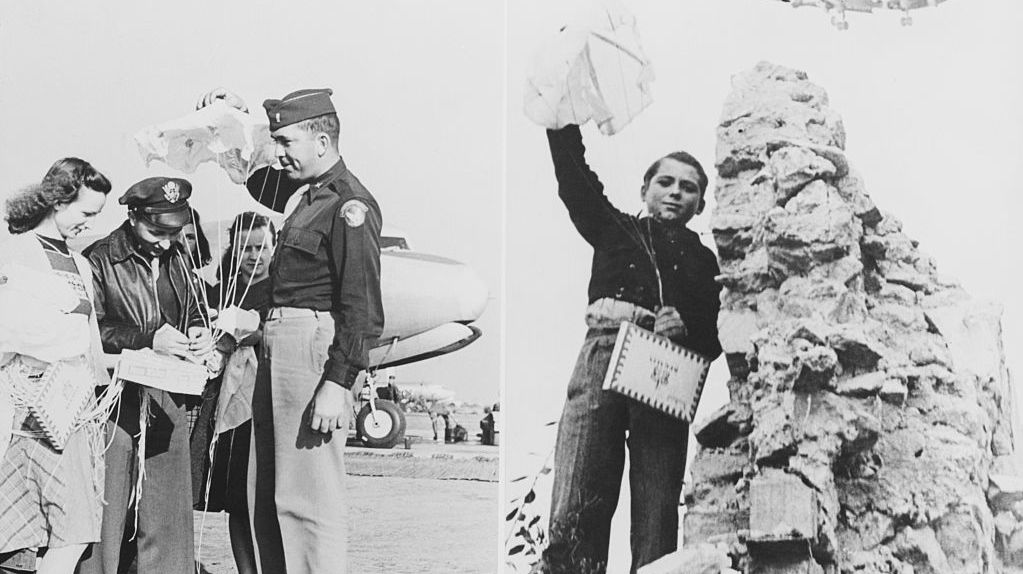This Tale Of A WWII "Candy Bomber" Will Have You Reaching For Tissues, Hershey Bars
Grab a box of tissues, folks, because by the time you're done reading this story, you'll have at least one tear slowly falling down your cheek. It's a story about kindness, generosity, empathy, and humanity. It involves innocent children, a war-ravaged country, and a nice reminder that love, and candy, conquers all.
In 1945, after Germany's surrender at the end of World War II, the nation was divided into four occupied zones to be controlled by United States, Great Britain, France, and the Soviet Union. By June of 1948, simmering tensions between Stalin's Soviet government and its former Allies reached crisis levels in Berlin; the capital was also split into four distinct zones and divided amongst the Allies, but was located entirely within the quadrant of Germany that was under Soviet control. Concerned by the influx of economic aid being supplied by the United States and efforts to unite the three Western-occupied zones, the Soviet Union attempted to drive their former Allies out of Berlin by blocking all rail, road, and canal access to the city. For nearly an entire year, the Berlin Blockade left nearly 2.5 million Germans with almost no access to food, medicine, fuel, electricity, and other basic goods. In response, Britain, France, and the United States launched airlift operations to deliver vital supplies to Berliners.
One of the U.S. Air Force pilots assigned to the operation was 27-year-old Gail "Hal" Halvorsen. After landing at Berlin's Tempelhof airfield on one of his first supply runs, Halvorsen noticed a small group of children standing behind a barbed wire fence; seeing that they were hungry, he reached into his pocket and pulled out the only food he had: two sticks of Wrigley's Spearmint gum. He tore the gum into small pieces so none of the children would have to go without, and promised that the next time he flew over Berlin, he'd airdrop a special delivery of candy.
"I told them that I'd 'wiggle' my wings so they'd know which pilot had the goods," said Halvorsen to The Washington Post. "Then I went back to the base and asked all the guys to pool their candy rations for the drop."
That first mission saw Halvorsen drop hundreds of Hershey's chocolate bars, tied to small parachutes made from handkerchiefs. The news of Halvorsen's candy drops spread, and the generosity of a single man grew into a full-blown effort named Operation Little Vittles that brought together the military, candy companies, private industry, and thousands of civilian volunteers to bring joy to the children of Berlin during the 15-month mission, concluding with one final drop on 10 major German cities on October 31, 1949.
This year, on October 10, Gail Halvorsen turned 100, and in the 72 years since he first pulled those two sticks of gum from his pocket, the kindness of the man that German children nicknamed "the Candy Bomber" has not been forgotten. At an outdoor birthday party attended by about 130 family members and friends, several people who experienced Halvorsen's generosity firsthand shared tributes to their childhood hero via Zoom. Ingrid Azvedo, now 86, was 14 years old when she went to watch the planes touch down at Tempelhof airfield, and she vividly remembers that tiny piece of gum Halvorsen handed her through the barbed wire fence. It was such an unbelievable gift in a time of darkness that she never ate it, instead keeping it underneath her pillow as a beacon of hope.
"I would smell it every night," she told The Washington Post. "And when he came back to drop chocolate instead of bombs, we could hardly believe it. Nobody had tasted chocolate for a very long time."
Another child, now 89-year-old Christel Jonge Vos, was never able to catch a chocolate parachute of his own, but said the chocolate itself was never the main prize.
"[It] was not important to me or the other kids who did not get one," said Vos. "We knew there was an American pilot called the Candy Bomber who cared about us. He laid the ground stone to the fact that enemies could become friends in Berlin."
Another child, Dagmar Snodgrass, now 86, eventually moved to America and became pen pals with Halvorsen.
"I was 14 and had seen too much evil to believe in anything good, when the Candy Bomber made a place for himself in the heart of every West Berlin child," she shared. "When a gust of wind carried that little parachute to me, you cannot imagine what it meant."
By the end of the Berlin Blockade, Operation Little Vittles had delivered more than 23 tons of candy and chocolate to children throughout Berlin. How many acts of love and generosity each piece went on to inspire is incalculable.
"Because of [Halvorsen]," shared Snodgrass, "we started to believe that good could come out of bad."
